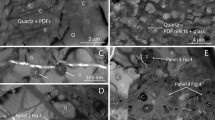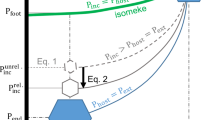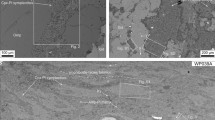Abstract
Atransmission electron microscope (TEM) study of quartz-coesite inclusions in garnet in crustal rocks from the Western Alps is presented. Coesite shows a low dislocation density (<107 cm−2), and quartz a higher density of defects, Brasil twins (104 cm−1) and dislocations (108 cm−2). It is concluded that coesite has been not or only slightly plastically deformed and that the yield strength of coesite is higher than that of quartz. The large scale deformation implications are briefly discussed. TEM observations show no systematic topotactic relationship between the two polymorphs and their boundaries have a scalloped morphology which suggests that growth of quartz from coesite was controlled by a diffusion process.
Similar content being viewed by others
References
Baëta RD, Ashbee KHG (1973) Transmission electron microscopy studies of plastically deformed quartz. Phys Status Solidi (a) 18:155–170
Bassett WA, Barnet JD (1970) Isothermal compression of stishovite and coesite up to 85 kilobars at room temperature by X-ray diffraction. Phys Earth Planet Inter 3:54–60
Bohlen SR, Boettcher AL (1982) The quartz — coesite transformation: a precise determination and the effects of other components. J Geophys Res 87:7073–7078
Boyd FR, England JL (1960) The quartz-coesite transition. J Geophys Res 65:749–756
Boyer H, Smith DC, Chopin C, Lasnier B (1985) Raman microprobe (RMP) determinations of natural and synthetic coesite. Phys Chem Minerals 12:45–48
Chao ECT, Shoemaker EM, Madsen BM (1960) First natural occurrence of coesite. Science 132:220–222
Chopin C (1983) High-pressure facies series in pelitic rocks: a review. Terra Cognita 3:183
Chopin C (1984) Coesite and pure pyrope in high-grade blueschists of the Western Alps: a first record and some consequences. Contrib Mineral Petrol 86:107–118
Christian JW (1975) The theory of transformations in metals and alloys. Pergamon Press, Oxford
Coe RS, Kirby SH (1975) The orthoenstatite to clinoenstatite transformation by shearing and reversion by annealing: mechanism and potential applications. Contrib Mineral Petrol 52:29–56
Coes L (1953) A new dense crystalline silica. Science 118:131–152
Doukhan JC, Trepied L (1985) Plastic deformation of quartz single crystals. Bull Mineral 108:97–123
Gillet Ph, Ingrin J, Chopin C (1984) Coesite in subducted continental crust: (P, T) history deduced from an elastic model. Earth Planet Sci Lett 70:426–436
Green HW (1972) Metastable growth of coesite in highly strained quartz. J Geophys Res 77:2478–2482
Ingrin J (1985) Microcopie électronique en transmission de géomatériaux. I volcanisme: Produits pyroclastiques des Antilles. II métamorphisme: Coesite dans un quarzite alpin. Thèse 3ème cycle Univ Paris VII
Kirby SH (1976) The role of crystal defects in the shear-induced transformation of orthoenstatite to clinoenstatite. In: Christie JM, Cowley J, Heuer A, Thomas G, Tighe N, Wenk HR (eds) Applications of electron microscopy in mineralogy. Springer, Berlin Heidelberg New York, pp 465–472
Kirby SH, McCormick JW (1979) Creep of hydrolytically weakened synthetic quartz crystals oriented to promote {2110} 〈0001〉 slip: a brief summary of work to date. Bull Mineral 102:124–137
Levien L, Prewitt CT (1981) High pressure crystal structure and compressibility of coesite. Am Mineral 66:324–333
McDonald GJF (1956) Quartz-coesite stability relations at high temperatures and pressures. Am J Sci 254:713–721
McLaren AC, Retchford JA, Griggs DT, Christie JM (1967) TEM study of brazil twins and dislocations experimentally produced in natural quartz. Phys Status Solidi 19:631–644
Mirwald PJ, Massonne HJ (1980) The low-high quartz and quartz-coesite transition to 40 kbar between 600° C and 1600° C and some reconnaissance on the effect of NaA102 component on the low quartz-coesite transition. J Geophys Res 85:6983–6990
Morrison-Smith DJ, Paterson MS, Hobbs BE (1976) An electron microscope study of plastic deformation in single crystals of synthetic quartz. Tectonophysics 33:43–79
Paterson MS (1983) Creep in transforming polycrystalline materials. Mech Materials 2:103–109
Poirier JP (1982) On transformation plasticity. J Geophys Res 87:6791–6797
Putnis A, McConnell JDC (1980) Principles of mineral behaviour. Blackwell Scientific Publications
Ramsdell LS (1955) The crystallography of “coesite”. Am Mineral 40:975–982
Rao CNR, Rao KJ (1978) Phase transition in solids. McGraw-Hill, New York
Sasaki S, Chen HK, Prewitt CT, Nakajima Y (1983) Re-examination of “P21/a coesite”. Z Kristallogr 164:67–77
Schreyer W (1985) Metamorphism of crustal rocks at mantle depths: high pressure minerals and mineral assemblages in metapelites. Fortschr Mineral 63:227–261
Smith DC (1984) Coesite in clinopyroxene in the Caledonides and its implications for geodynamics. Nature 310:541–544
Smyth JR, Hatton CJ (1977) A coesite-sanidine Grospydite from the Roberts Victor Kimberlite. Earth Planet Sci Lett 34:284–290
Sobolev NV (1976) Coesite, garnet and omphacite inclusions in Yakutsk diamonds — first finding of coesite paragenesis. Dokl Akad Nauk SSSR 230:1422–1444 (in Russian) Abstr: Mineral Abstr 78-818
Werner-Kieffer S, Phakey PP, Christie JM (1976) Shock processes in porous quartzite: Transmission electron microscopic observations and theory. Contrib Mineral Petrol 59:41–96
White SM, Knipe RJ (1978) Transformation and reaction-enhanced ductility in rocks. J Geol Soc London 135:513–516
Zoltaì T, Buerger MJ (1959) The crystal structure of coesite, the dense high-pressure form of silica. Z Kristallogr 111:129–141
Van Goethem L, Van Landuyt J, Amelinckx S (1977) The α–β transition in amethyst quartz as studied by electron microscopy and diffraction. Phys Status Solidi (a) 41:129–137
Van Tendeloo J, Van Landuyt J, Amelinckx S (1976) The α–β phase transition in quartz and AlPO4 as studied by electron microscopy and diffraction. Phys Status Solidi (a) 33:723–735
Author information
Authors and Affiliations
Rights and permissions
About this article
Cite this article
Ingrin, J., Gillet, P. TEM investigation of the crystal microstructures in a quartz-coesite assemblage of the western alps. Phys Chem Minerals 13, 325–330 (1986). https://doi.org/10.1007/BF00308349
Received:
Issue Date:
DOI: https://doi.org/10.1007/BF00308349




